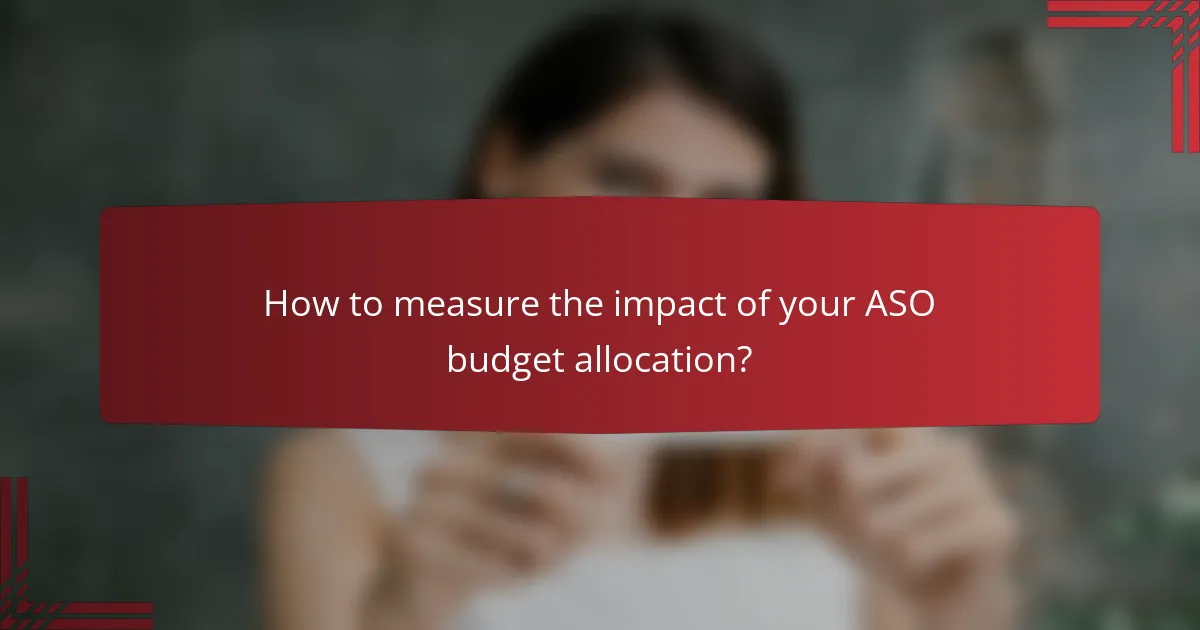Effectively allocating your ASO budget is crucial for maximizing your app’s visibility and driving downloads. By prioritizing high-traffic keywords, investing in essential tools, and analyzing your competitors, you can significantly enhance your app’s performance in the app store. Understanding the various components of your budget, such as keyword research and marketing costs, will enable you to make informed decisions that lead to better results.

How to effectively allocate your ASO budget for maximum impact?
To allocate your ASO budget effectively, focus on strategies that enhance visibility and drive downloads. Prioritizing high-traffic keywords, investing in tools, and analyzing competitors can significantly improve your app’s performance in the app store.
Prioritize high-traffic keywords
Identifying and prioritizing high-traffic keywords is crucial for maximizing your ASO budget. Use keyword research tools to find terms that potential users are searching for, focusing on those with high search volume and low competition.
Consider targeting a mix of short-tail and long-tail keywords. Short-tail keywords can drive more traffic, while long-tail keywords often convert better due to their specificity. Aim for a balanced approach to capture a wider audience.
Invest in app store optimization tools
Investing in app store optimization tools can streamline your ASO efforts and provide valuable insights. Tools like Sensor Tower or App Annie can help you track keyword rankings, analyze competitors, and optimize your app listing.
Allocate a portion of your budget to these tools based on your app’s size and market competition. A monthly subscription can range from a few hundred to several thousand dollars, depending on the features you need.
Focus on user acquisition channels
Identifying and focusing on effective user acquisition channels is essential for maximizing your ASO budget. Channels such as social media, influencer marketing, and paid ads can drive targeted traffic to your app.
Evaluate the cost-effectiveness of each channel. For instance, social media ads may yield a lower cost per acquisition compared to traditional advertising. Test different channels to see which ones provide the best return on investment.
Analyze competitor spending
Analyzing competitor spending can provide insights into effective ASO strategies and help you allocate your budget wisely. Look at competitors’ marketing campaigns, keyword strategies, and user acquisition costs to identify trends.
Tools like SEMrush can help you estimate competitor ad spend and keyword performance. Understanding where your competitors invest can guide your own budget allocation and highlight areas for improvement.
Utilize data analytics for budget adjustments
Utilizing data analytics is vital for making informed budget adjustments in your ASO strategy. Regularly review performance metrics such as download rates, conversion rates, and user engagement to assess the effectiveness of your spending.
Set up a system for tracking key performance indicators (KPIs) and adjust your budget based on what the data reveals. For instance, if a particular keyword or channel is underperforming, consider reallocating funds to more successful strategies.

What are the key components of an ASO budget?
An ASO budget typically includes costs associated with keyword research, design and development, and marketing and advertising. Understanding these components helps in allocating funds effectively to enhance app visibility and downloads.
Keyword research costs
Keyword research is crucial for optimizing app store listings. Costs can vary based on tools used, ranging from free options to premium services costing around $50 to $200 per month. Investing in quality keyword research can significantly improve your app’s discoverability.
Consider using a mix of tools to analyze competition and search trends. This approach helps in identifying high-traffic keywords that align with your app’s features, ensuring a better return on investment.
Design and development expenses
Design and development expenses encompass the creation of app icons, screenshots, and overall user interface enhancements. Depending on complexity, these costs can range from a few hundred to several thousand dollars. Prioritizing high-quality visuals can lead to higher conversion rates.
When budgeting, factor in both initial design and ongoing updates. Regularly refreshing visuals based on user feedback and market trends can keep your app competitive and appealing.
Marketing and advertising allocations
Marketing and advertising are essential for driving downloads and user engagement. Allocate a portion of your budget—typically 20-30%—to paid advertisements, social media campaigns, and influencer partnerships. This investment can yield substantial returns if targeted effectively.
Monitor the performance of your marketing efforts closely. Adjust your budget based on which channels deliver the best results, ensuring that your spending aligns with user acquisition goals and overall app performance.

How to measure the impact of your ASO budget allocation?
Measuring the impact of your ASO budget allocation involves tracking key performance indicators that reflect your app’s visibility and user engagement. By focusing on app store rankings, user engagement metrics, and conversion rates, you can assess the effectiveness of your spending and make informed adjustments.
Track app store rankings
Monitoring app store rankings is crucial for understanding how well your app performs against competitors. Regularly check your app’s position for relevant keywords and categories, as these rankings directly influence visibility and downloads. Tools like App Annie or Sensor Tower can help automate this tracking.
Consider setting benchmarks based on your historical performance and industry standards. Aiming for a top 10 position in your category can significantly increase organic downloads, while lower rankings may indicate the need for budget reallocation or strategy adjustments.
Analyze user engagement metrics
User engagement metrics, such as session length and daily active users, provide insight into how well your app retains users. High engagement often correlates with effective ASO strategies, indicating that your budget is well spent. Use analytics tools like Google Analytics or Mixpanel to gather this data.
Look for trends in user behavior after implementing ASO changes. If engagement metrics improve following a budget increase in keyword optimization or creative assets, it suggests a positive impact. Conversely, stagnant or declining metrics may signal the need for a different approach.
Monitor conversion rates
Conversion rates measure how many users download your app after viewing it in the app store. This metric is essential for evaluating the effectiveness of your ASO efforts, including app descriptions, visuals, and reviews. A good conversion rate typically ranges from 20% to 30%, but this can vary by industry.
To improve conversion rates, test different elements of your app store listing. A/B testing can help identify which images or descriptions resonate best with potential users. If you notice low conversion rates despite high traffic, consider reallocating your budget to enhance your app’s presentation or address user feedback.

What are the common mistakes in ASO budget allocation?
Common mistakes in ASO budget allocation can significantly hinder your app’s visibility and growth. Key pitfalls include neglecting ongoing optimization, underestimating marketing costs, and ignoring competitor analysis.
Neglecting ongoing optimization
Ongoing optimization is crucial for maintaining and improving your app’s ranking in app stores. Many developers allocate their budget primarily for initial launch efforts, forgetting that continuous updates and adjustments are necessary to respond to market changes and user feedback.
To avoid this mistake, set aside a portion of your budget—typically around 20-30%—for regular ASO activities, such as keyword updates, A/B testing of app visuals, and user review management. This ensures your app remains competitive over time.
Underestimating marketing costs
Marketing costs can often be higher than anticipated, leading to budget shortfalls. Many app developers overlook expenses related to paid user acquisition, influencer partnerships, and promotional campaigns, which can be essential for driving downloads.
To mitigate this risk, create a detailed marketing plan that includes a realistic estimate of costs. Allocate at least 30-50% of your ASO budget for marketing efforts, especially if you are in a highly competitive niche.
Ignoring competitor analysis
Failing to analyze competitors can result in missed opportunities and ineffective strategies. Understanding how similar apps allocate their budgets and optimize their ASO can provide valuable insights into what works and what doesn’t.
Invest time and resources in competitor analysis by using tools that track their keywords, rankings, and user engagement strategies. This can help you identify gaps in your own approach and adjust your budget allocation accordingly to stay ahead in the market.

How can you adjust your ASO budget over time?
Adjusting your ASO budget over time is essential for maximizing its impact. By continuously evaluating performance and user engagement, you can allocate funds more effectively to enhance visibility and downloads.
Regularly review performance metrics
Consistently analyzing performance metrics helps identify which strategies are yielding results. Focus on key indicators such as conversion rates, keyword rankings, and user acquisition costs. This data will inform whether to increase or decrease spending in specific areas.
Set a schedule for reviews, such as monthly or quarterly, to ensure you stay on top of trends. Use tools like App Store Analytics or Google Play Console to gather insights and make data-driven decisions.
Reallocate funds based on user feedback
User feedback is invaluable for optimizing your ASO budget. Pay attention to reviews and ratings to understand user preferences and pain points. This information can guide you in reallocating funds to features or marketing efforts that resonate more with your audience.
Consider conducting surveys or utilizing in-app feedback tools to gather more structured insights. Adjust your budget to prioritize enhancements that users value, which can lead to improved retention and conversion rates.
Test different marketing strategies
Experimenting with various marketing strategies allows you to discover what works best for your app. Allocate a portion of your budget to A/B testing different elements such as app descriptions, visuals, and promotional campaigns. This can reveal which approaches drive the most downloads.
Keep tests manageable by focusing on one variable at a time, and ensure you have enough data to draw meaningful conclusions. Use the insights gained to refine your overall ASO strategy and budget allocation for maximum impact.

What tools can assist in ASO budget allocation?
Several tools can significantly enhance your ASO budget allocation by providing insights into market trends, competitor strategies, and user behavior. Utilizing these tools effectively can help you make informed decisions on where to invest your resources for maximum impact.
App Annie for market insights
App Annie is a powerful tool for gaining market insights that can inform your ASO budget allocation. It provides data on app performance, user demographics, and market trends, allowing you to identify opportunities and threats in your niche.
When using App Annie, focus on metrics such as download trends and revenue estimates for your competitors. This information can help you gauge where to allocate your budget, whether it’s for keyword optimization, creative assets, or user acquisition campaigns.
Consider setting up alerts for significant changes in competitor performance or market shifts. This proactive approach ensures you stay ahead and adjust your budget allocation as needed to maintain a competitive edge.

